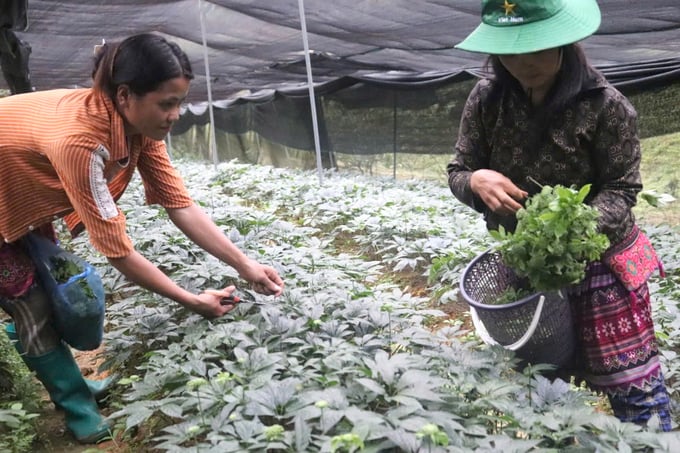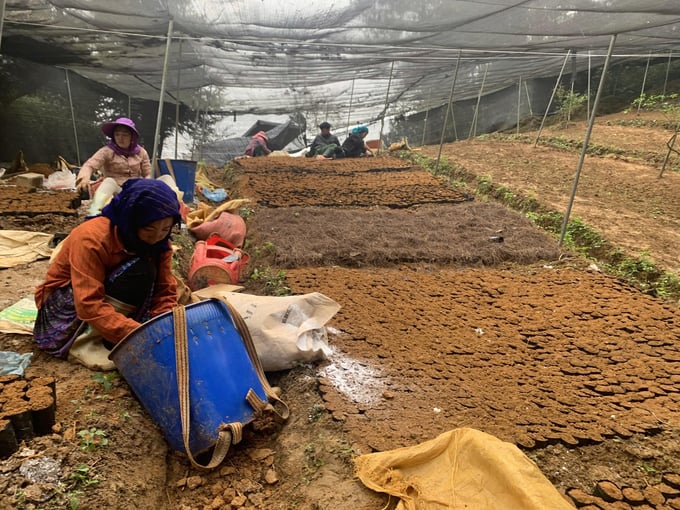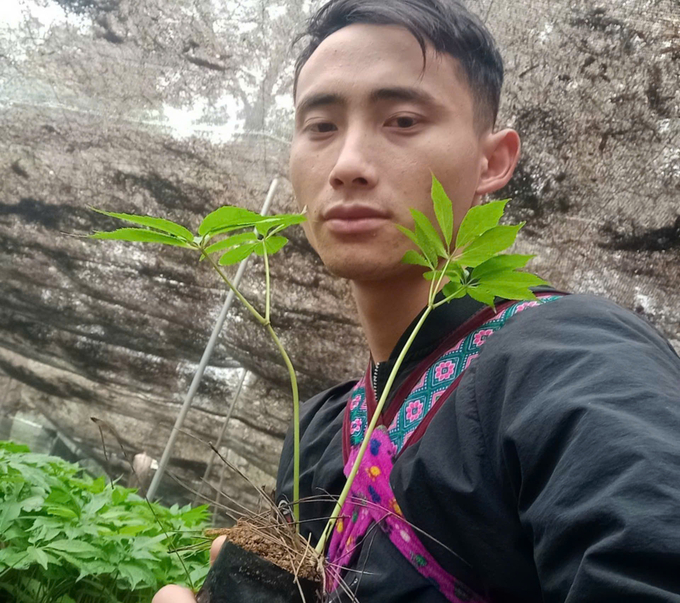November 26, 2025 | 05:48 GMT +7
November 26, 2025 | 05:48 GMT +7
Hotline: 0913.378.918
November 26, 2025 | 05:48 GMT +7
Hotline: 0913.378.918

People harvest flowers and buds of panax notoginseng. Photo: H.D.
The climate in the highland communes of Bac Ha (Lao Cai) is consistently mild and humid, with a humidity level of 70-80%. This environment is favorable to the cultivation of valuable medicinal plants, such as panax notoginseng.
This economically valuable plant assists mountain residents in the alleviation of poverty and the gradual improvement of their quality of life.
Previously, Mr. Sung Seo Kenh of Ta Van Chu commune utilized his over 2 hectares of hillside fields to cultivate rice and corn; however, these endeavors were not exceedingly profitable. He decided to concentrate on growing and upkeep of panax notoginseng, as he recognized that it could enhance his family's income.
The flowers and blooms of panax notoginseng plants can be harvested after two years, and they can be used in either medicine or tea, depending on the intended use. Harvesting the roots of the plants is feasible when they reach six to seven years of age. As the plant continues to develop, its economic value increases.
Numerous households in Nam Mon commune have initiated the cultivation of panax notoginseng due to the favorable climate and soil conditions. After witnessing his younger brother, Mr. Sung Seo Thin, achieve financial stability through the cultivation of medicinal plants, Mr. Sung Seo Binh of Nam Mon resolved to cultivate over three hectares of tam that.
His family's panax notoginseng nursery produced more than 100 kilograms of panax notoginseng flower blossoms in late October, which were sold for approximately 600,000 VND per kilogram. This resulted in tens of millions of dong. Mr. Sung Seo Quynh was able to acquire domestic appliances and cover certain anticipated expenditures with this income.

The area where panax pseudoginseng is grown in pots in Bac Ha. Photo: H.D.
Co De Chai Agricultural Cooperative has successfully planted nearly 10 hectares of tam that as a result of the systematic implementation of a medicinal plant cultivation model. In order to guarantee that the entire process—from soil preparation to harvest—meets technical standards, they have established purchasing and support contracts with local producers.
Mr. Dang Quang Trung, Director of Co De Chai Agricultural Cooperative, disclosed that the cooperative furnishes farmers with net dwellings, fertilizer, techniques, and seedlings. Farmers allocate their labor to cultivate and maintain the vegetation on their properties. Farmers receive 36 million VND annually for the preservation and maintenance of their gardens. The labor required for weeding and plant maintenance is calculated separately and paid per phase. Profits are divided 50-50 after the costs of seeds, fertilizers, and labor are taken into account following the harvest and sale of the product.

Mr. Sung Seo Binh has now mastered the technique of propagating panax pseudoginseng seedlings. Photo: H.D.
For years, the residents of Bac Ha have been cultivating Panax notoginseng, a precious medicinal plant. panax notoginseng is well-suited to the cultivation capabilities of highland residents and has the potential to expand planting areas due to its strong resistance to pests, minimal technical requirements, and low planting and care costs.
Using humus or composted organic fertilizer to ensure soil nutrients, panax notoginseng is cultivated without the use of chemical fertilizers, as per Mr. Dang Quang Trung. Use of chemical fertilizers impedes the plant's growth, thereby decreasing its medicinal properties. Chemical components can cause the plant to gradually expire and stunt over time, affecting the soil.
Before planting, the soil undergoes testing to guarantee that it is devoid of herbicides and heavy metals. Supplementing nutrients with organic humus throughout successive seasons. Composting for 12-16 months involves the combination of wild wormwood and decomposed leaves with microorganisms and lime powder. Pig manure is high in nitrogen, while cattle and buffalo manure contains grass spores, and chicken manure is high in potassium. It is important to consider these factors when using animal manure. The processing of these forms of manure is required before its use.
When preparing the soil, selecting light, loose soil is essential, ideally with an east-southeast exposure. To prevent disease transmission, the soil should not have previously grown panax notoginseng or be near other panax notoginseng areas. The soil is plowed three to four times, weeds removed, and sterilized with a 1% copper sulfate solution. Raised beds are 1.2 - 1.5 meters wide, with furrows 25-30 cm deep to prevent waterlogging in the rainy season. In mountainous areas, soil is prepared from the base up.
Translated by Linh Linh

(VAN) The Ministry of Agriculture and Environment must spearhead the construction of green governance, spanning decision-making processes and investment standards to policy evaluation mechanisms.

(VAN) The Agriculture and Environment sector of Khanh Hoa has achieved numerous milestones over the past 80 years, contributing significantly to the goal of establishing the province as a centrally governed city by 2030.

(VAN) Viet Nam is entering the pivotal period of 2025-2030, moving toward the formulation of the Remote Sensing Law, which will establish a legal foundation for the development of national digital data.

(VAN) The agricultural sector is finalizing the strategic framework for emission reduction, setting the goal of sharply cutting methane and 403.7 million tons of CO2 equivalent and moving toward Net Zero by 2050.
/2025/11/22/2236-1-153832_483.jpg)
(VAN) The National Marine Spatial Planning is opening up opportunities for sustainable blue sea development across 21 coastal localities.

(VAN) Viet Nam’s forestry sector is undergoing a comprehensive transformation, strengthening management, protection, and development efforts to maintain ecological security and drive green, sustainable growth.

(VAN) Viet Nam is accelerating efforts to digitize reservoir operations, from real-time data to hydraulic modelling.